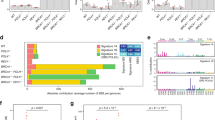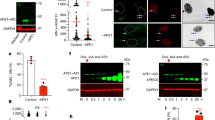Abstract
The Cockayne syndrome B (CSB) gene product is involved in the repair of various types of base modifications in actively transcribed DNA sequences. To investigate its significance for the repair of endogenous oxidative DNA damage, homozygous csb−/−/ogg1−/− double knockout mice were generated. These combine the deficiency of CSB with that of OGG1, a gene coding for the mammalian repair glycosylase that initiates the base excision repair of 7,8-dihydro-8-oxoguanine (8-oxoG). Compared to ogg1−/− mice, csb−/−/ogg1−/− mice were found to accumulate with age severalfold higher levels of oxidited purine modifications in hepatocytes, splenocytes and kidney cells. In contrast, the basal (steady-state) levels of oxidative DNA modifications in cells from csb−/− mice were not different from those in wild-type mice and did not increase with age. The analysis of the repair rates of additional oxidative DNA base modifications induced by photosensitization in immortalized embryonic fibroblasts was in accordance with these findings: compared to wild-type cells, the global repair was only slightly affected in csb−/− cells, more compromised in ogg1−/− cells, but virtually absent in csb−/−/ogg1−/− cells. An inhibition of transcription by α-amanitin did not block the Csb-dependent repair in ogg1−/− fibroblasts. The influence of Csb on the global repair of 8-oxoG was not detectable in assays with total protein extracts and in a shuttle vector system. The data indicate a role for Csb in the removal of 8-oxoG from the overall genome that is independent of both Ogg1-mediated base excision repair and regular transcription.
This is a preview of subscription content, access via your institution
Access options
Subscribe to this journal
Receive 50 print issues and online access
$259.00 per year
only $5.18 per issue
Buy this article
- Purchase on Springer Link
- Instant access to full article PDF
Prices may be subject to local taxes which are calculated during checkout






Similar content being viewed by others
References
Ames BN, Shigenaga MK, Hagen TM . 1993 Proc. Natl. Acad. Sci. USA 90: 7915–7922
Bochar DA, Wang L, Beniya H, Kinev A, Xue Y, Lane WS, Wang W, Kashanchi F, Shiekhattar R . 2000 Cell 102: 257–265
Bohr VA, Smith CA, Okumoto DS, Hanawalt PC . 1985 Cell 40: 359–369
Boiteux S, Radicella JP . 2000 Arch. Biochem. Biophys. 377: 1–8
Boiteux S, O'Connor TR, Lederer F, Gouyette A, Laval J . 1990 J. Biol. Chem. 265: 3916–3922
Bruner SD, Norman DPG, Verdine YL . 2000 Nature 403: 859–866
Cheng KC, Cahill DS, Kasai H, Nishimura S, Loeb LA . 1992 J. Biol. Chem. 267: 166–172
Citterio E, Van Den Boom V, Schnitzler G, Kanaar R, Bonte E, Kingston RE, Hoeijmakers JH, Vermeulen W . 2000 Mol. Cell. Biol. 20: 7643–7653
Dianov G, Bischoff C, Sunesen M, Bohr VA . 1999 Nucleic Acids Res. 27: 1365–1368
Doll R, Peto R . 1981 J. Natl. Cancer. Inst. 66: 1191–1308
Friedberg EC . 1996 Ann. Rev. Biochem. 65: 15–42
Hazra TK, Izumi T, Maidt L, Floyd RA, Mitra S . 1998 Nucleic Acids Res. 27: 4001–4007
Hazra TK, Izumi T, Boldogh I, Imhoff B, Kow YW, Jaruga P, Dizdaroglu M, Mitra S . 2002 Proc. Natl. Acad. Sci. USA 99: 3523–3528
Hengstler JG, Utesch D, Steinberg P, Platt KL, Diener B, Ringel M, Swales N, Fischer T, Biefang K, Gerl M, Bottger T, Oesch F . 2000 Drug. Metab. Rev. 32: 81–118
Hollenbach S, Dhénaut A, Eckert I, Radicella JP, Epe B . 1999 Carcinogenesis 20: 1863–1868
Kapranov P, Cawley SE, Drenkow J, Bekiranov S, Strausberg RL, Fodor SPA, Gingeras TR . 2002 Science 296: 916–919
Klungland A, Lindahl T . 1997 EMBO J. 16: 3341–3348
Klungland A, Rosewell I, Hollenbach S, Larsen E, Daly G, Epe B, Seeberg E, Lindahl T, Barnes DE . 1999 Proc. Natl. Acad. Sci. USA 96: 13300–13305
Kohn KW, Erickson LC, Ewig RAG, Friedman CA . 1976 Biochemistry 15: 4629–4637
Le Page F, Guy A, Cadet J, Sarasin A, Gentil A . 1998 Nucleic Acids Res. 26: 1276–1281
Le Page F, Klungland A, Barnes DE, Sarasin A, Boiteux S . 2000a Proc. Natl. Acad. Sci. USA 97: 8397–8402
Le Page F, Kwoh EE, Avrutskaya A, Gentil A, Leadon SA, Sarasin A, Cooper PK . 2000b Cell 101: 159–171
Le Page F, Randrianarison V, Marot D, Cabannes J, Perricaudet M, Feunteun J, Sarasin A . 2000c Cancer Res. 60: 5548–5552
Lichtenstein P, Holm NV, Verkasalo PK, Iliadou A, Kaprio J, Koskenvuo M, Pukkala E, Skytthe A, Hemminki K . 2000 N. Engl. J. Med. 343: 78–85
Lindahl T, Wood RD . 1999 Science 286: 1897–1905
Michaels ML, Miller JH . 1992 J. Bacteriol. 174: 6321–6325
Minowa O, Arai T, Hirano M, Monden Y, Nakai S, Fukuda M, Itoh M, Takano H, Hippou Y, Aburatani H, Masumura K, Nohmi T, Nishimura S, Noda T . 2000 Proc. Natl. Acad. Sci. USA 97: 4156–4161
Moriya M . 1993 Proc. Natl. Acad. Sci. USA 90: 1122–1126
Osterod M, Hollenbach S, Hengstler JG, Barnes DE, Lindahl T, Epe B . 2001 Carcinogenesis 22: 1459–1463
Pflaum M, Will O, Epe B . 1997 Carcinogenesis 18: 2225–2231
Risch N . 2001 Cancer Epidemiol. Biomarkers Prev. 10: 733–741
Seeberg E, Eide L, Bjøras M . 1995 Trends Biol. Sci. 20: 391–397
Sunesen M, Stevnsner T, Brosh Jr RM, Dianov GL, Bohr VA . 2002 Oncogene 21: 3571–3578
Thomas D, Scot AD, Barbey R, Padula M, Boiteux S . 1997 Molec. Gen. Genet. 254: 171–178
Thorslund T, Sunesen M, Bohr VA, Stevnsner T . 2002 DNA repair 1: 261–273
Todaro GJ, Green H . 1963 J. Cell Biol. 17: 299–313
Tomatis L (ed) . 1990 Cancer: causes, occurrence, and control. Lyon, France: IARC scientific publications
Tornaletti S, Hanawalt PC . 1999 Biochimie 81: 139–146
Tuo J, Muftuoglu M, Chen C, Jaruga P, Selzer RR, Brosh Jr RM, Rodriguez H, Dizdaroglu M, Bohr VA . 2001 J. Biol. Chem. 276: 45772–45779
Van der Horst GT, van Steeg H, Berg RJ, van Gool AJ, de Wit J, Weeda G, Morreau H, Beems RB, van Kreijl CF, de Gruijl FR, Bootsma D, Hoeijmakers JH . 1997 Cell 89: 425–435
Venema J, Mullenders LH, Natarajan AT, van Zeeland AA, Mayne LV . 1990 Proc. Natl. Acad. Sci. USA 87: 4707–4711
Will O, Gocke E, Eckert I, Schulz I, Pflaum M, Mahler HC, Epe B . 1999 Mutat. Res. 435: 89–101
Wood ML, Dizdaroglu M, Gajewski E, Essigmann JM . 1990 Biochemistry 29: 7024–7032
Ye Q, Hu YF, Zhong H, Nye AC, Belmont AS, Li R . 2001 J. Cell. Biol. 155: 911–921
Acknowledgements
We thank Dr Deborah Barnes (Cancer Research UK, London) for providing ogg1−/− mice. This work was supported by the Deutsche Forschungsgemeinschaft (SFB 519), the PROCOPE program and the Association pour la Recherche sur le Cancer (No 5432 to S Boiteux). E Larsen and A Klungland acknowledge the support from the Norwegian Cancer Society, the Top research Program, the Research Council of Norway and support to the ‘DNage’ collaboration by the EU.
Author information
Authors and Affiliations
Corresponding author
Rights and permissions
About this article
Cite this article
Osterod, M., Larsen, E., Le Page, F. et al. A global DNA repair mechanism involving the Cockayne syndrome B (CSB) gene product can prevent the in vivo accumulation of endogenous oxidative DNA base damage. Oncogene 21, 8232–8239 (2002). https://doi.org/10.1038/sj.onc.1206027
Received:
Revised:
Accepted:
Published:
Issue Date:
DOI: https://doi.org/10.1038/sj.onc.1206027
Keywords
This article is cited by
-
Comparative study of cytotoxic effects induced by environmental genotoxins using XPC- and CSB-deficient human lymphoblastoid TK6 cells
Genes and Environment (2019)
-
Transcription-coupled nucleotide excision repair in mammalian cells: molecular mechanisms and biological effects
Cell Research (2008)
-
The role of CSA in the response to oxidative DNA damage in human cells
Oncogene (2007)
-
Deficiency of the Cockayne syndrome B (CSB) gene aggravates the genomic instability caused by endogenous oxidative DNA base damage in mice
Oncogene (2007)
-
Base-excision repair of oxidative DNA damage
Nature (2007)



